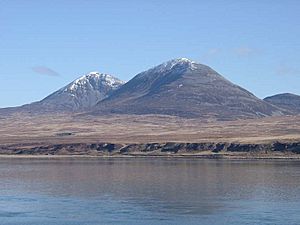Hinba facts for kids
Hinba is a mysterious island in Scotland. It was once home to a small monastery connected to Columba's famous church on Iona. Even though we know some things about the monastery and its early leaders, no one today is sure exactly where Hinba was located. Most of what we know comes from a book called Vita Columbae, written by Adomnán in the late 600s.
Many islands are thought to be Hinba. The most likely ones are Eileach an Naoimh, Jura, Colonsay, and Oronsay. Other possibilities include Seil and Canna.
The name 'Hinba' probably comes from an old Scottish language called Goidelic. Many island names in Scotland changed after the Vikings arrived around 900 AD. This might be why Hinba's name disappeared from maps and records.
Contents
What Does the Name Hinba Mean?
Some experts, like Watson, believe "Hinba" is a Latin version of the Old Irish word inbe, meaning "an incision" or "a cut". This idea supports Jura as the location, because Jura has deep sea inlets and a clear gap between its mountains.
However, island names can be very old and hard to understand. Some might even be older than Celtic languages. So, trying to figure out the island's name might not be the best way to find it.
Another idea from Murray is that Hinba comes from the old Gaelic words in (island) and ba (sea). He thought the original name might have been Na Hinba, meaning "the isles of the sea".
The Monastery's Beginning and Leaders
Columba (521–597) is a very important saint in Scotland. He arrived in Scotland from Ireland in 563. He was given land on Iona, which became the center for his work spreading Christianity to the Picts.
Monks often used quiet, isolated places called 'deserts' for prayer and reflection. Hinba was one of these smaller monasteries linked to Iona. Columba himself enjoyed visiting Hinba for quiet contemplation.
We don't know exactly when Hinba was built. It was likely between 564 and 574. This is because there's a story about Columba getting a message from an angel on Hinba to make Aedan mac Gabrain the King of Dal Riata, which happened in 574. Adomnán's book suggests there was one main monastery and a smaller hermitage on Hinba.
St. Ernan, Columba's uncle, was the first leader of the Hinba monastery. He was one of the twelve people who came with Columba from Ireland to Iona. Adomnán wrote that Ernan was only the leader for a few days. Columba had a feeling he wouldn't see his uncle again. A few days later, Ernan got sick and wanted to see Columba on Iona. As they were about to meet, Ernan suddenly died.
Baithéne mac Brénaind was the second head of Iona (597–600). Before that, he managed the monasteries on both Hinba and Tiree.
Adomnán shared several stories about Columba and the Hinba monastery:
- Once, Columba was on Hinba and allowed monks doing penance to eat more food. A monk named Neman mac Cathir refused this offer. Columba told him that someday he would be in a forest with thieves, eating stolen horse meat. This prediction later came true.
- In another story, Columba was on Hinba when some men attacked churches. One of these men came to Columba and tried to stab him with a spear. A monk wearing Columba's cloak jumped in the way. The cloak miraculously stopped the spear, and the attacker left, thinking he had killed Columba.
Where Could Hinba Be?
Eileach an Naoimh
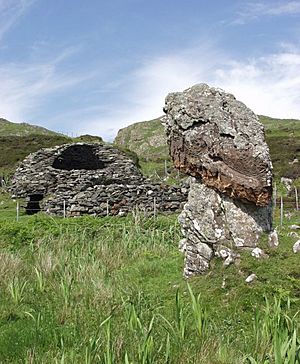
This is a small, rocky island in the Garvellachs group. People believe Columba visited Eileach an Naoimh, and his mother might be buried there. However, Adomnán described a settlement that sounds larger than this island, which is only about 56 hectares (138 acres).
Adomnán also mentioned a place called Muirbolcmar on Hinba, where a hermitage was located. This Gaelic name means "the great sea-bag". Some experts say this description doesn't fit Eileach an Naoimh's rocky coast.
However, Adomnán wrote that Brendan the Navigator sailed from Ireland to visit Columba and found him on Hinba. Brendan might have stopped at a monastery he had founded years before on an island called "Ailech". Ailech is almost certainly Eileach an Naoimh. This suggests Hinba could be Ailech, just under a different name.
Jura
Jura is a much larger island, about 6 miles (10 km) southeast of the Garvellachs. It is on the main sea route between Scotland and Ireland. Jura has a large sea inlet called Loch Tarbert, which could fit the "great sea-bag" description. The name "Hinba" might also come from the Old Irish word for "incision," which could describe Loch Tarbert or the famous gap between Jura's mountains, the Paps of Jura.
However, some scholars think "Muirbolcmar" describes Hinba's location, not a place on the island itself. They believe it refers to the Firth of Lorn, which is a "great sea-bag."
Some local names on Jura also hint at a connection. There's a local name for Jura, t-Eilean Ban ('the blessed isle'). Also, a cave on Jura's coast is called Uaimh mhuinn tir Idhe ('the cave of the folk of Hy'). Plus, Ernan, who was once the leader of Hinba, is thought to be buried at Kellernandale on Jura.
Oronsay
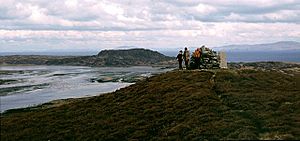
Watson also considered Oronsay. This island is connected to Colonsay at low tide. It had a monastery in the Middle Ages. The bay between Oronsay and Colonsay has a "bag-like horn" shape to the north. Oronsay is also on the route from Ireland to Iona. Columba first landed here on his way from Ireland to Iona, but he kept going when he realized he could still see Ireland from Oronsay's highest point.
The name Oronsay might come from "Oran's Isle," named after St Oran, a friend of Columba. Oran founded the island's first monastery in 563. However, other islands named Oronsay get their name from an Old Norse word meaning "tidal" or "ebb island." So, the name's origin isn't a clear clue.
Canna
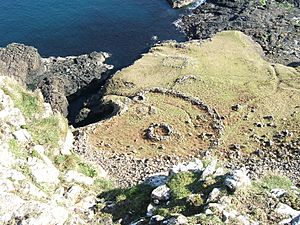
Canna is another possible location, near Rùm, about 64 miles (103 km) northwest of the Garvellachs. Watson thought Hinba was likely on the route from Ireland, as saints coming from Ireland found Columba there. Canna is quite far north of Iona, making it an unlikely stop on that journey.
However, a strong argument has been made for Canna because many early Christian items have been found there. One expert, O'Neil, points out that the story of four saints visiting Columba on Hinba doesn't mean they traveled from Ireland to Iona through Hinba. She also suggests that "muirbolc" might mean "a place where fast-flowing water is held," which could fit a site near the modern village of A'Chill on Canna.
Seil
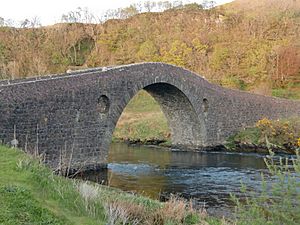
The island of Seil is northeast of the Garvellachs and close to the mainland. Rae (2011) suggested Seil as Hinba's location. His reasons include its connection to Brendan, its position on a coastal trade route, and its suitability for a large settlement. He thinks Muirbolcmar could refer to the Seil Sound and the narrow area at Clachan Bridge, where water rushes under the bridge.
He also connects "Hinba" to the Gaelic word Inbhir, meaning "river mouth." The nearby mainland area, Kilninver, means "church of Inbhir." He suggests that the name "Seil" might come from a Norse word meaning "passage of water," which could be how the Norse understood Hinba/Inbhir.
However, Seil is not on a direct route from Ireland to Iona. Also, there are very strong tides in this area, which might have made it difficult for early sailors.
Colonsay
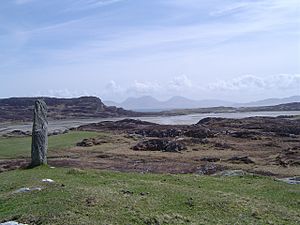
Colonsay is a larger island next to Oronsay, separated by a narrow channel that dries at low tide. Expert Kelly Kilpatrick believes Hinba is likely Colonsay, or perhaps both Colonsay and Oronsay. She thinks the name Muirbolc már ("great sea-bag") refers to The Strand, the area between Colonsay and Oronsay, which becomes mostly dry at low tide.
One scholar, MacEachern, noted that Adomnán mentioned an island called Hinbina ("Little Hinba"). Only Colonsay and Oronsay offer a large and a small island together, which fits this description. Canna also has a smaller tidal island, Sanday, so this isn't a completely unique clue.
Mystical Events on Hinba
Adomnán wrote about several amazing events that happened to Columba on Hinba:
- When St. Comgall, St. Brendan, and two other saints visited Columba on Hinba, Brendan saw a bright ball of fire above Columba's head during a church service. This light stayed there, rising like a flame, until the service ended.
- On another visit to Hinba, Columba had "heavenly visions and revelations" that lasted for three days and nights.
- In another story, Columba was on Hinba at night when he saw an angel. The angel had a glass book about how to make kings. Columba read the book, which told him to make Áedán mac Gabráin the king of Dal Riata. Columba didn't want to, because he thought Áedán's brother was a better choice. The angel then hit Columba with a whip, leaving a scar he had for the rest of his life. The angel told Columba firmly that he was sent by God to make Áedán king. The angel returned for three nights. After this, Columba left Hinba for Iona, where Áedán was waiting to be made king.




